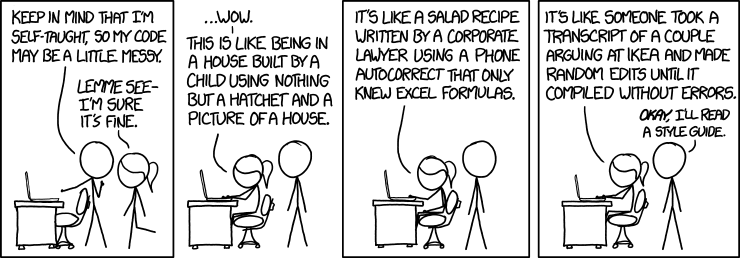MSS Code Guidelines
Version 1.3.1
Contributors
YOU! - please contribute to these code guidelines! If you have any suggestions for improvement to these guidelines, create an issue to discuss it or create a pull request with your changes and discussion will occur on that PR. Also review the contributing guidelines.
Original Authors
- James Young @jamsyoung, github
- Matt Crutchfield @mtcrutch, github
Conflict Resolution
We have included JSHint and JSCS RC files in this repository
to validate javascript code against these guidelines. When something is
questioned, these files will always win. When in doubt, run JSHint and JSCS
with the .jshintrc and .jscsrc files in place and see if they find any
problems. It is recommended that you find plugins for your editor of choice to
always validate your code against these files.
Regarding the multiple suffixed files
There are several .jscs and .jshintrc files with suffixes in this repo. It
is up to you to choose the most appropriate one for your project. Hopefully the
suffixes are clear, but just in case, here are some more details.
-
.jscs: A JavaScript Code Style config file for ECMAScript 5 code.
-
.jscs-es6: A JavaScript Code Style config file for ECMAScript 6 code.
-
.jshintrc-browser: A JS Hint config file for browser based ECMAScript 5 code.
-
.jshintrc-node: A JS Hint config file for NodeJS 0.10.x ECMAScript 5 code.
-
.jshintrc-node-es6: A JS Hint config file for NodeJS 0.11.x+ and IO.js ECMAScript 6 code.
JavaScript
The JavaScript guidelines are based off of idiomatic.js. Currently ES5 is supported in all MSS client side applications. ES6 can be written on the server by running node with the harmony flag or using io.js.
- Do not use ES6 for client side applications. Currently ES6 requires transpilation to be ready for production. If you are working on an internal project, then its ok to mess around with ES6. If you do use it, beware you will bleed and feel the side effects of living on the edge.
- For the daring, check out jspm, systemjs and use with either bable or typescript
For lots of code examples that show the style we want, see the airbnb guide.
The MSS Guidelines will be the same with the following additional rules applied.
Idiomatic Style Manifesto
-
Whitespace
- 4-space soft indents are required. This means four spaces or four spaces representing a tab.
- Spaces not Tabs
- set up your text editor to always convert tabs into spaces
- EOL
- set up your text editor to always have trailing spaces on save
-
Beautiful Syntax
-
2.A - 2.C should not have
inner-space. Refer to 2.D for a syntax withoutinner-space. Here is an example.function foo(bar, baz) { var i, qux = bar + baz; for (i = 0; i < 10; i++) { console.log(qux); } if (bar === baz) { qux = bar * baz; } else { qux = bar / baz; } return qux; }
-
Single quotes must be used.
-
Object literals should look like this.
var objectLiteral; objectLiteral = { foo: 'bar', baz: 'qux' };
-
Milliseconds should be assigned in multiples of 1000, and always use explicit order of operations.
var oneSecond = 1000 * 1, oneMinute = 1000 * 60, fiveMinutes = (1000 * 60) * 5;
-
Test Facility
Testing is broken out into two parts.
Client Side
- Karma as the test runner
- Mocha for the test framework
- Chai for assertions
- Protractor for e2e tests
- PhantomJS / ChromeCanary / Chrome / Firefox / Safari / IE 10 / IE 9 as the supported browsers
Starting a new project
cd $PROJECT
npm init // follow prompts
npm install karma --save-dev
karma init // follow prompts- ES6 code can be written in tests, but it needs to ran through a karma pre-processor. For now just write tests in good old ES5 and lets wait until things stabilize a little before we start using ES6 in tests or any JavaScript we write for that matter.
Server Side
- Mocha for the test framework
- Chai for assertions
- Selenium WebdriverJS for e2e tests
- Code coverage is not always the goal of projects that we write. Quality tests are more important. When writing tests make sure that all logical pathways are being covered and take the time to dive deep into whatever function is being used.
HTML
- Write clean semantic HTML5 markup.
- Use double quotes for attributes.
- Use proper indention.
- Selector Attributes
Never use an ID as a styling hook.
Prefix any JavaScript class hooks with
js-. Example:class="js-foo foo" - Closing
<li>elements.<li>elements should not be closed. Further reading on this inline-block issue.
CSS / Sass
- The CSS / Sass guidelines are based off of csswizardry/CSS-Guidelines.
- We use nomalize.css as our style reset.
Our CSS / Sass overrides
- Declarations. Declarations should be in alphabetical order (NOT by relevance).
Markdown
- All lines that are not code blocks should wrap at or under 80 columns.
- Should allow trailing whitespace, since that is a valid Markdown syntax.
- Should have 2 blank lines above each H1 and H2 heading except for the heading at the top of the document. This is optinal for other headings.
- Should have 4 blank lines to separate the link reference at the bottom of the document.
- Should use
0.for ordered lists - Should use
-for unordered lists - Secondary bullets must be indented four spaces to render correctly on Bitbucket.
- Do not try to put code blocks as secondary bullets in a list. They will not render correctly on both GitHub and BitBucket. More details on this to come in the future.
